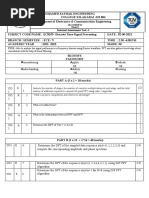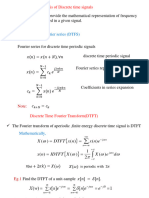0 ratings0% found this document useful (0 votes)
145 viewsAssignment 1 - DFT
The document contains 17 questions related to digital signal processing concepts like DFT, IDFT, FFT, DIT, DIF algorithms. It asks to find DFTs and IDFTs of various sequences, calculate number of multiplications for different transforms, explain concepts like zero padding and twiddle factors.
Uploaded by
Santhoshi KCopyright
© © All Rights Reserved
Available Formats
Download as DOCX, PDF, TXT or read online on Scribd
0 ratings0% found this document useful (0 votes)
145 viewsAssignment 1 - DFT
The document contains 17 questions related to digital signal processing concepts like DFT, IDFT, FFT, DIT, DIF algorithms. It asks to find DFTs and IDFTs of various sequences, calculate number of multiplications for different transforms, explain concepts like zero padding and twiddle factors.
Uploaded by
Santhoshi KCopyright
© © All Rights Reserved
Available Formats
Download as DOCX, PDF, TXT or read online on Scribd
You are on page 1/ 3
EC6502 DIGITAL SIGNAL PROCESSING
ASSIGNMENT I
PART A
1. Write expression for DFT and IDFT pair?
2. What is the difference between DTFT and DFT?
3. How is FFT computationally efficient?
4. Find the DFT of an impulse signal.
5. Find the DFT of x(n)=an.
6. Find the DFT of a sequence x (n) = {1, 1, 0, 0 }.
7. What is meant by Radix-2 FFT?
8. What is Decimation-in-time algorithm?
9. What is the basic operation of DIF algorithm?
10. Calculate the number of multiplications needed in the calculation of DFT and FFT with
64 point sequence.
11. What is meant by in – place in DIT and DIF algorithms?
12. How will you perform linear convolution using circular convolution?
13. What is zero-padding? What are its uses?
14. How many multiplications and additions are required to compute N-point DFT using
radix –2 FFT?
15. Draw the basic butterfly diagram for the computation in the DIT-FFT & DIF-FFT
16. List any four properties of DFT.
17. Write the expression for twiddle factor.
18. In which FFT algorithm, the output is bit reversed?
19. Compute the DFT of the sequence whose values for one period is given by x (n) = {1, 1, -
2, -2}.
20. Distinguish between linear and circular convolution.
21. Calculate the DFT of the sequence x (n) = (1/4)n for N = 2.
22. Find the circular convolution of two sequences {1, 2, 2, 1} and {1, 2, 3, 1}.
23. Given x(n) = {0, 1, 2, 3}, find X (k) using DIT – FFT algorithm.
PART-B
1. Calculate the DFT of (1/4)n , for N=8.
2. a) Find the circular convolution of the finite duration sequences x1(n)={1, -1, -2, 3,-1},
x2(n)={1,2,3}.
b) Perform the circular convolution of the sequences x1(n)={1,1,2,1}, x2(n) = {1,2,3,4}
using concentric circle method.
3. Compute the DFT of the sequence x(n) = 1 ; 0< n < 7
0 ; otherwise
using the DIT-FFT algorithm.
4. Compute the 8-point DFT of the sequence
x(n) = {0.5, 0.5, 0.5, 0.5, 0, 0, 0, 0} using DIT-FFT algorithm.
5. Compute the 8-point DFT of the sequence x(n) = {1, 1, 1, 1, 1, 1, 1, 1} using DIF-FFT
algorithm.
6. Compute the 8-point DFT of the sequence
x(n) = {0.5, 0.5, 0.5, 0.5, 0, 0, 0, 0} using DIF-FFT algorithm.
7. Compute the IDFT of the sequence X(K) = {7, -0.707-j0.707, -j, 0.707-j0.707, 1,
0.707+j0.707, j , -0.707+j0.707} using DIT-FFT algorithm.
8. Given x(n)={ 1, 2, 3, 4, 4, 3, 2, 1} Find X(K) using DIT-FFT algorithm.
9. Given x(n)= 2n and N=8. Find X(K) using DIT-FFT algorithm.
10. Given x(n)= n +1 and N=8. Find X(K) using DIT-FFT algorithm.
11. Given x(n)={0, 1, 2, 3, 4, 5, 6, 7}. Find X(K) using DIF-FFT algorithm
12. Compute the 8-point DFT of the sequence x(n) = {1, 1, 1, 1, 0, 0, 0, 0} using DIT-FFT
algorithm.
13. Given X(K)= { 20, -5.828- j2.414, 0, -0.172-j0.414, 0, -0.172 + j0.414, 0, -5.828 +
j2.414}.Find x(n)
14. Find the DFT of the sequence x(n)={1, 1, 1, 1, 0, 0, 0, 0} using DIT-FFT algorithm.
15. Find the DFT of the sequence x(n)={2, 2, 2, 2, 1, 1, 1,1} using DIT-FFT algorithm.
16. Find the DFT of the sequence x(n)={1, 0, 1, 0, 1, 0, 1,0} using DIT-FFT algorithm.
17. Find the IDFT of the sequence X(K)= { 4, 1-j2.414, 0, 1-j0.414, 0, 1+j0.414, 0,
1+j2.414} using DIF-FFT algorithm.
Prepared by
M.Dhanalakshmi
You might also like
- Cell Structure (Grade 6) - Free Printable Tests and Worksheets PDF90% (10)Cell Structure (Grade 6) - Free Printable Tests and Worksheets PDF2 pages
- Ec6502-Principles of Digital Signal Processing: Assignment - 1No ratings yetEc6502-Principles of Digital Signal Processing: Assignment - 11 page
- 17EC3601 - DSP - Assignment - I Questions - 2020-21No ratings yet17EC3601 - DSP - Assignment - I Questions - 2020-211 page
- 17EC3601 - DSP - Assignment - I Questions - 2020-21No ratings yet17EC3601 - DSP - Assignment - I Questions - 2020-211 page
- 17EC3601 - DSP - Assignment - I Questions - 2020-21No ratings yet17EC3601 - DSP - Assignment - I Questions - 2020-211 page
- Ec 6502 Principles of Digital Signal Processing - Question Bank - 2018No ratings yetEc 6502 Principles of Digital Signal Processing - Question Bank - 201817 pages
- Bharathi Education Trust G. Madegowda Institute of Technology (Gmit)No ratings yetBharathi Education Trust G. Madegowda Institute of Technology (Gmit)10 pages
- Bharathi Education Trust G. Madegowda Institute of Technology (Gmit)No ratings yetBharathi Education Trust G. Madegowda Institute of Technology (Gmit)11 pages
- Question Bank Unit I Part A: Ae306-Digital Signal Processing AEINo ratings yetQuestion Bank Unit I Part A: Ae306-Digital Signal Processing AEI4 pages
- Question Bank For Digital Signal ProcessingNo ratings yetQuestion Bank For Digital Signal Processing8 pages
- SL - No Questions: MODULE 1: Discrete Fourier TransformNo ratings yetSL - No Questions: MODULE 1: Discrete Fourier Transform5 pages
- One Mark Questions:: EC431 Digital Signal Processing Unit-IINo ratings yetOne Mark Questions:: EC431 Digital Signal Processing Unit-II3 pages
- Unit I Discrete Fourier Transform Part B April 2018) : Ec 8553 - Discrete Time Signal Processing Question BankNo ratings yetUnit I Discrete Fourier Transform Part B April 2018) : Ec 8553 - Discrete Time Signal Processing Question Bank8 pages
- EC3492 - DIGITAL SIGNAL PROCESSING-923183941-question Bank DSP 21 RegNo ratings yetEC3492 - DIGITAL SIGNAL PROCESSING-923183941-question Bank DSP 21 Reg18 pages
- MGM's College of Engineering, Nanded: Department of Electronics and TelecommunicationNo ratings yetMGM's College of Engineering, Nanded: Department of Electronics and Telecommunication3 pages
- Digital Signal Processing Two Mark Question With Answer Unit III100% (1)Digital Signal Processing Two Mark Question With Answer Unit III4 pages
- EC3492 - DIGITAL SIGNAL PROCESSING-923183941-question Bank DSP 21 RegNo ratings yetEC3492 - DIGITAL SIGNAL PROCESSING-923183941-question Bank DSP 21 Reg17 pages
- Inverse Trigonometric Functions (Trigonometry) Mathematics Question BankFrom EverandInverse Trigonometric Functions (Trigonometry) Mathematics Question BankNo ratings yet
- Unit - 4 Artificial Intelligence AssignmentNo ratings yetUnit - 4 Artificial Intelligence Assignment13 pages
- Coduri de Defect: Combustibil (EKPS (Fuel Pump Control) - Diagnose)No ratings yetCoduri de Defect: Combustibil (EKPS (Fuel Pump Control) - Diagnose)4 pages
- Provisional Graduation List Website 04.10.24No ratings yetProvisional Graduation List Website 04.10.2442 pages
- Betty Azar English Worksheets (Elementary) - Chapter 10 - Expressing Future Time, Part 1No ratings yetBetty Azar English Worksheets (Elementary) - Chapter 10 - Expressing Future Time, Part 124 pages
- Specialist Gynaecologist Hamilton Waikato NZ 3204No ratings yetSpecialist Gynaecologist Hamilton Waikato NZ 32043 pages
- OPC UA Part 2 - Security Model 1.03 SpecificationNo ratings yetOPC UA Part 2 - Security Model 1.03 Specification39 pages
- USA V Kevin Seefried Sentencing Memo by USANo ratings yetUSA V Kevin Seefried Sentencing Memo by USA42 pages
- Surface Area and Porosity Determinations by Physisorption: Measurement, Classical Theories and Quantum Theory 2Nd Edition James B. Condon - Ebook PDF100% (3)Surface Area and Porosity Determinations by Physisorption: Measurement, Classical Theories and Quantum Theory 2Nd Edition James B. Condon - Ebook PDF51 pages

























































































